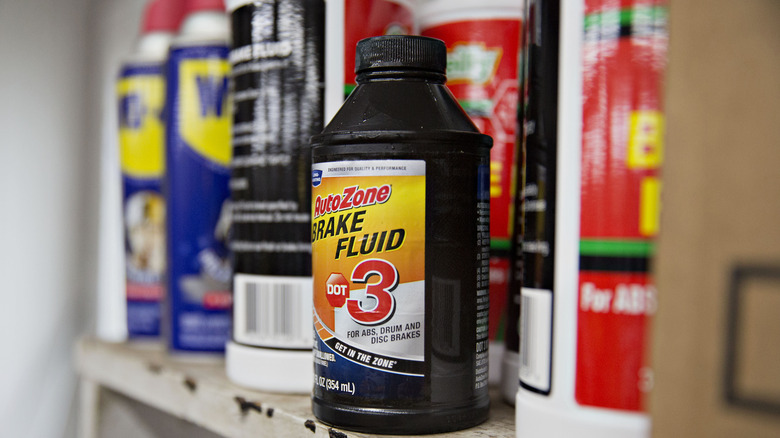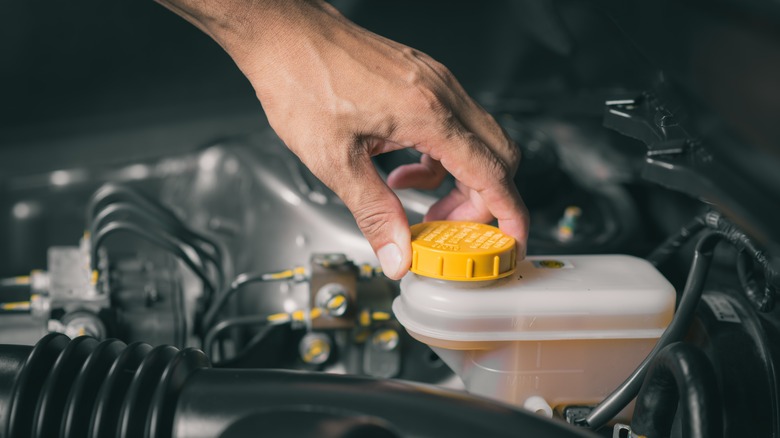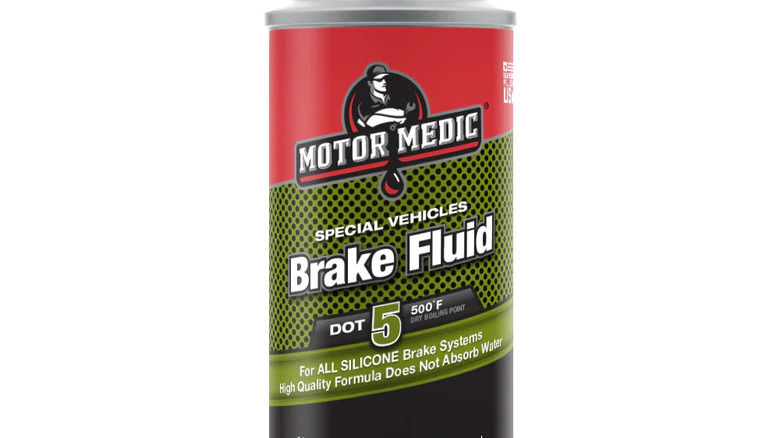Brake Fluid Types Explained (And How To Pick The Right One For Your Car)
Of all the systems in your car, perhaps the most important to your safety are the brakes. Modern vehicles use hydraulic fluid to transmit pressure from a master cylinder to individual cylinders at each wheel via fluid contained in the brake lines. On wheels with disc brakes, calipers squeeze brake pads inward onto the discs to slow the wheels, while on wheels with drum brakes, brake shoes exert outward force on the inner surface of the brake drum. Many modern vehicles have disc brakes in front and drum brakes in the rear, although some have discs on all four wheels. This configuration is becoming more common, as disc brakes are more effective, reliable, and easier to maintain than drum brakes.
Proper brake operation relies on pads that aren't worn past their point of effectiveness. Many have a compound that will emit a telltale squeal when they wear down far enough that the brake pads need to be replaced. It's also important to make sure that your brake system has enough of the correct type of fluid at all times. This keeps the pressure in the system high enough to ensure quick and smooth operation on all four wheels.
Your car should indicate which brake fluid type is best
On most vehicles, the brake fluid reservoir is attached to the master cylinder or brake booster, which is generally bolted to the firewall on the driver's side. The cap often has a dipstick that will indicate if the level is sufficient. If not, there should be markings on the side of the reservoir itself. Brake fluid is classified by DOT (Department of Transportation) type. The fluid reservoir cap should be stamped with the recommended fluid type. You can also consult your owner's manual or call your dealership's service department to identify the correct brake fluid type for your vehicle. Using the wrong fluid can severely compromise brake performance or cause damage to your brake system.
DOT 3 is the most commonly used type of brake fluid. It's amber in color and has a boiling point of 401º F when fresh and 284ºF when fully degraded. It is glycol-based and will quickly corrode paint, so if you spill it, clean it up quickly with soapy water and degreaser. DOT 4 fluid is mostly used in European cars, but it's becoming more widely used across the globe. It is also glycol-based but has a slightly higher boiling point than DOT 3 fluid. Mercedes and Volvo vehicles use a variant called DOT 4 Plus, and some BMWs use a version called DOT 4 Low Viscosity. There's also a variety called DOT 4 Racing Fluid, which has borate ester added to the glycol base. This raises the boiling point and gives it a bluish tint.
DOT 5 fluid has a different composition from the other types
DOT 3 and DOT 4 brake fluids are hygroscopic, meaning they will absorb water from your brake system. DOT 5 fluid is silicone-based and non-hygroscopic, and it should not be used in DOT 3 or DOT 4 systems or mixed with those fluids. DOT 5 fluid is usually purple to distinguish it from the amber-colored DOT 3 and DOT 4 fluids. Because it is difficult to bleed air from DOT 5 fluid, it's usually not used in vehicles with anti-lock braking (ABS) systems. It is, however, appropriate for vehicles that sit for long periods of time without being driven, like antiques or military trucks. DOT 5 fluid has a boiling point of 500ºF.
By the nomenclature alone, DOT 5.1 fluid might seem similar to DOT 5 fluid, but it is in fact more akin to DOT 3 and DOT 4 fluids. DOT 5.1 fluid has a borate ester base with glycol additives and has a boiling point roughly equal to that of DOT 4 fluids. It is clear to amber in color. DOT 5.1 fluid is generally safe to use in vehicles that call for DOT 3 or DOT 4 fluids, but mixing them can compromise the capabilities of either fluid, so it's best to have your brake system bled of air and fluid before switching the fluid type.


